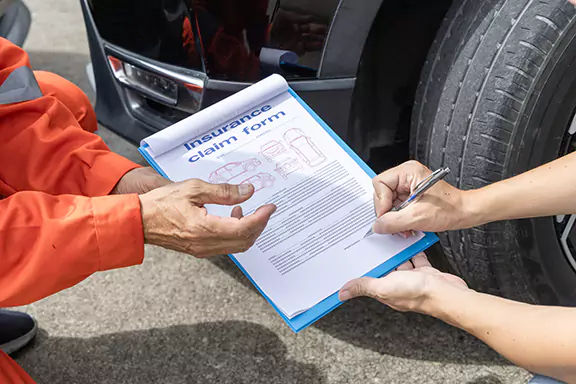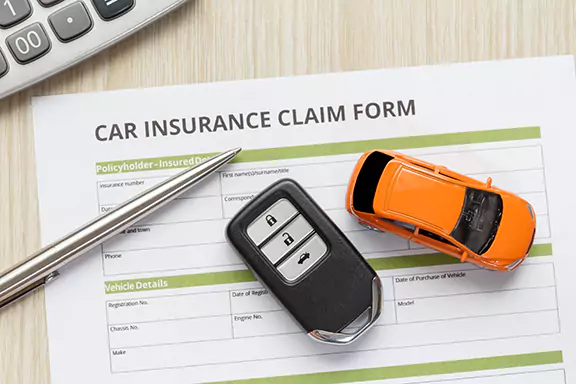Filing an auto insurance claim might seem stressful, especially if you’re new to the process or unfamiliar with how insurance works in the U.S. Whether you’ve been in an accident, your car has been stolen, or it’s been damaged by weather, knowing what to do next can make a big difference.
This guide will walk you through the steps of how to file an auto insurance claim, explain what to expect along the way, and help you avoid common mistakes. By understanding the process, you can feel more confident and make sure you get the coverage you deserve when you need it most.
What is an Auto Insurance Claim?
An auto insurance claim is a formal request you make to your insurance company asking for compensation or coverage after your vehicle has been damaged or stolen. It is how you get your insurance company to cover the costs according to the terms of your auto insurance policy.
There are different types of insurance claims that you might file depending on the situation. For example:
Accident Claims: If you’re involved in a car accident, you’ll need to file a claim to cover damages to your vehicle or any medical expenses resulting from the crash.
Theft or Vandalism Claims: If your car is stolen or vandalized, you’ll file a claim to help cover the costs of repairs or replacement.
Natural Disaster Claims: If your car is damaged by a storm, flood, or other natural event, your insurance policy may cover these damages, depending on your coverage.
Understanding the basics of filing an insurance claim can help you feel more confident when the time comes to use your coverage.
Steps to File an Auto Insurance Claim
Filing an insurance claim doesn’t have to be complicated. By following these steps, you can make sure the process goes smoothly and that you get the coverage you need.
Step 1: Collect Information
After an accident or incident, the first thing you should do is gather as much information as possible. This includes:
Driver’s Information: Collect the names, contact details, and insurance information of everyone involved in the accident.
Vehicle Details: Note the make, model, and license plate numbers of all vehicles involved.
Location and Time: Record where and when the incident occurred. This helps your insurance company understand the situation.
Witnesses: If there are witnesses, get their contact information. Their statements could be valuable later.
Photos: Take pictures of the damage to your vehicle, other vehicles, and the overall scene. Clear photos are essential evidence when filing your claim.
Step 2: Contact the Police (If Required)
In many cases, especially accidents involving other vehicles, contacting the police is important. They will create an official report that documents the details of the incident. This report can be crucial for your insurance claim, as it helps determine who was at fault.
Even if the accident seems minor, having a police report can protect you if any disputes with the other driver arise later. When the police arrive, stick to the facts—avoid admitting fault or blaming others. Be sure to get the officers’ names, badge numbers, and contact information for future reference.
Step 3: Document the Damage
It’s essential to document the damage to your vehicle thoroughly. Take detailed photos from different angles and write notes describing the damage. If other vehicles or other property damage were involved, document those as well. The more evidence you have, the easier it will be to support your claim.
Step 4: Contact Your Insurance Company
Once you have all the necessary information, contact your insurance company as soon as possible. You can usually file a claim online, through a mobile app, or by calling your insurer. Provide all the details you’ve collected, and be prepared to explain what happened.
Make sure to get a claim number from your insurance company. This number will be your reference for your insurance payment and tracking the progress of your claim.
Step 5: Work with an Insurance Adjuster
After you file your claim, an insurance adjuster will be assigned to your case. The adjuster’s job is to assess the damage to your vehicle, determine the cost of repairs, and decide on the payout. They may ask for additional documentation or schedule an inspection of your vehicle.
Stay in touch with your adjuster and respond promptly to any requests. This helps ensure your claim is processed as quickly as possible.
Step 6: Arrange Repairs
Once your claim is approved, you’ll need to arrange for your vehicle to be repaired. Your insurance company may provide a list of approved repair shops, but you’re generally free to choose your own. Make sure you understand how payment will be handled—whether your insurer will pay the shop directly or reimburse you after the repairs are completed.
Step 7: Understand the Payment Process
After the repair costs are determined, your insurance company will issue payment. If your vehicle is repairable, the insurer may pay the repair shop directly minus your collision deductible, or you may receive a check to cover the costs.
If your car is totaled, the insurance company will compensate you for the market value of your vehicle, minus your deductible.

Timeline for Filing a Claim
Understanding the timeline for filing a claim is important to ensure your claim is processed smoothly. While the exact timeline can vary depending on your insurance company and the details of the incident, here’s a general overview of what to expect:
1. Immediately After the Incident
Collect Information: Right after the incident, gather all necessary details, such as driver information, photos, and a police report.
Report the Claim: Contact your insurance company as soon as possible. Many insurers require you to report a claim within a specific time frame, often 24 to 48 hours after the incident.
2. Within a Few Days
Insurance Adjuster Contact: After you file the claim, an insurance adjuster will typically reach out within a few days to start assessing the damage and reviewing your documentation.
3. Within One to Two Weeks
Inspection and Repair Estimates: The adjuster may schedule an inspection of your vehicle and provide an estimate for repairs. If you need to get estimates from repair shops, this process can take about a week or two.
4. Within 30 Days
Claim Resolution: Most insurance companies aim to resolve claims within 30 days. This includes approving your claim, arranging for repairs, and issuing payment.
5. Final Steps
Repairs and Payment: Once your claim is approved, repairs can be scheduled, and payment will be issued. If your vehicle is totaled, you’ll receive compensation for its market value.
Keep in mind that some states have specific deadlines for filing claims. If you miss these deadlines, your claim could be denied, so it’s important to act quickly.
Common Pitfalls and How to Avoid Them
Filing an insurance claim can be straightforward, but there are some common pitfalls that can complicate the process. Here’s how to avoid them:
1. Delaying Filing
Pitfall: Waiting too long to file a claim can lead to complications or even denial of your claim.
How to Avoid It: File your claim as soon as possible after the incident. The sooner you report it, the sooner the insurance company can start processing your claim.
2. Inaccurate or Incomplete Information
Pitfall: Providing incorrect or incomplete information can delay your claim or result in a lower payout.
How to Avoid It: Double-check all the details you provide, including driver information, accident details, and any documentation. Accuracy is key to ensuring a smooth claims process.
3. Not Understanding Your Deductible
Pitfall: Being unaware of your deductible can lead to unexpected out-of-pocket costs.
How to Avoid It: Review your insurance policy to know exactly how much your deductible is. This will help you understand what portion of the repair costs you’re responsible for.
4. Choosing the Wrong Repair Shop
Pitfall: Using a non-approved repair shop can result in delays or issues with your insurance company covering the repairs.
How to Avoid It: If your insurer recommends specific repair shops, consider using one of them to ensure a smooth payment process. If you choose your own, verify that they meet your insurance company’s requirements.
5. Not Following Up
Pitfall: Assuming your claim is being processed without checking in can lead to delays or missed steps.
How to Avoid It: Stay in regular contact with your insurance adjuster and repair shop. Follow up on any outstanding issues to keep the process moving.
Helpful Tip: Stay Calm and Focused After an Accident
In the stressful moments after an accident, it’s important to stay calm and take emotion out of the situation, regardless of who is at fault. Once you’ve ensured that everyone is safe, follow these key steps:
Notify the Police: Always call the police to report the accident, even if it seems minor. Their report will be crucial for your insurance claim.
Exchange Information: Make sure to trade contact and insurance details with the other party. Don’t just rely on their word that they will follow up, especially if they are at fault.
Document Everything: Take photos, gather witness contact information, and write down what happened. Don’t leave the scene without this documentation, as it may be legally impossible to prove what occurred later, which could lead to your claim being denied.
By staying focused and gathering the right information, you protect yourself and your ability to file a successful claim.

Frequently Asked Questions (FAQs)
How long do I have to file a claim?
The time limit for filing a claim varies by state and insurance company, but it’s best to file a car insurance call as soon as possible—ideally within 24 to 48 hours after the incident. Some states have specific deadlines, so check with your insurer to make sure you meet the requirements.
What if I don’t have a police report?
In some cases, such as minor accidents, a police report may not be required. However, it’s always a good idea to get one if possible. If you don’t have a police report, provide as much documentation as possible, including photos and witness statements, to support your claim.
Can I choose my own repair shop?
Yes, you can usually choose your own repair shop, but it’s a good idea to check with your insurance company first. They may have a list of preferred shops that meet their standards, which can make the process smoother and ensure the repairs are covered.
What happens if my car is totaled?
If your car is considered a total loss, your insurance company will pay you the market value of the vehicle, minus your deductible. You can use this payment to purchase a new vehicle. If you owe more on your car loan than the car’s value, gap insurance can help cover the difference.
What should I do if my car insurance claim is denied?
If your claim is denied, ask your insurance company for a written explanation. Review the reasons for the denial and provide any additional information or documentation that may help. If you believe the denial is unjustified, you can appeal the decision to your state insurance department or seek legal advice.
Protect Yourself by Carefully Following Every Step in the Claim Process
Filing an auto insurance claim can feel overwhelming, especially if you’re not familiar with the process. By following the steps outlined in this guide, you can ensure that your auto claim is handled efficiently and that you receive the coverage you’re entitled to. Remember to act quickly, provide accurate information, and stay in touch with your insurance company throughout the process.
Review Your Coverage and Explore Your Options
If you’re unsure about your current coverage, it’s a good idea to review your policy. Understanding what is covered—and what isn’t—can save you from unexpected surprises. If your policy is up for renewal, take the opportunity to compare costs from other auto insurance companies, speak with an insurance agent, and explore different coverage options. This way, you can ensure you have the protection you need at a price that fits your budget.

